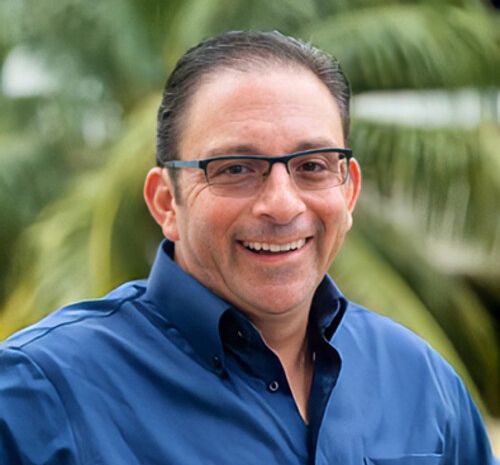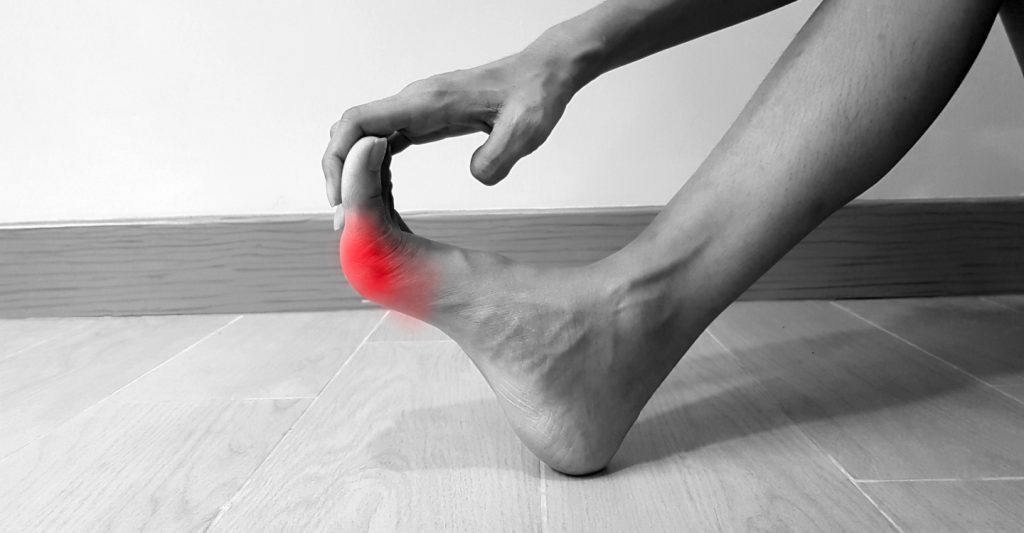A bunion is an often painful deformity that forms where the big toe connects with the foot. Incorrect footwear and developmental problems can cause the big toe to bend inwards towards the smaller toes. Over time, a bony bump develops, leading to pain and inflammation.
Bunions develop over time and often only become painful once they reach an advanced stage. You can get bunion treatment with your podiatrist.
A few common myths about bunions and bunion surgery could be more helpful and may even prevent you from getting the needed treatment. Let’s explore them and put them to rest with your knowledgeable foot and ankle doctor. Remember it’s not your grandmother’s bunion surgery.
Myth #1: You Don’t Need Surgery
The first myth about bunions is that you can reverse a bunion without surgery. It is common for patients to come into the office inquiring about ways to reverse their bunion. Many over-the-counter devices claim to realign the bunion, bringing the big toe to a straight position. This is a myth about bunions because a bunion is a deviation of the big toe joint. There is no way to reverse it without performing surgery. The joint must be realigned through surgical correction. However, with the use of Orthotics and better footwear we can help slow progression of the bunion and reduce the pain associated with it.
Myth #2: High Heels Cause Bunions
A second myth about bunions is that high heels cause bunions. A bunion is caused by your foot type. The shoes you wear and your activities will worsen it, but it is caused by heredity. Heredity and genetics play the biggest role in bunions. In your family history, if somebody has a bunion, you are more prone to developing that bunion regardless of the shoes you wear. High heel shoes and pointy-toed shoes aggravate the condition and worsen it; however, it is not the underlying cause. A lot of men develop bunions, and many men do not wear high heels.
Myth #3: Bunion Surgery Is Painful
The third myth about bunions is that surgery is extremely painful. Bunion surgery is not as painful today as it was 10-20 years ago. With the advances in technique and hardware patients typically have less post operative pain and are back to activities faster than ever.
You won’t feel pain during the procedure, and any pain after surgery can be managed with medication. A lot of patients are afraid to undergo bunion surgery. They have heard horror stories and read many online reviews stating that bunion surgery is painful.
What I will say about bunion surgery is that you require the appropriate post-op care to minimize discomfort as much as possible at the beginning.
It is typically the inflammation that causes the most pain. When you put your foot down after surgery, blood will rush to the area, the foot swells, and pain starts. Once the swelling is in the foot, it is challenging to get it out. You must be able to commit to the healing after bunion surgery and do not plan on performing activities for two weeks. Do not let this myth about bunions stop you from seeking treatment.
Your podiatrist will explain the expected outcome in detail to make you comfortable with the procedure. Ultimately, any pain you experience after bunion surgery will be minor compared to avoiding treatment and dealing with a painful bunion for the rest of your life.
Myth #4: You Don’t Need to Treat a Bunion Until It’s Painful
Any foot pain is a sign that you need to see your podiatrist. While pain is often tolerated, it’s never normal. Ignoring pain or simply living through it could cause problems to progress, requiring more extensive treatment or surgery. Sometimes the pain can be eliminated or reduced with proper shoe gear and orthotics.
When considering a bunion, it’s important to seek treatment as soon as the problem is discovered. Some common symptoms of a bunion include:
- Inflamed and red skin on the outer side of your big toe.
- Calluses form on your second toe, where the big toe causes friction.
- Thick skin underneath your big toe.
- Persistent foot pain.
- Difficulty when moving your big toe.
- Difficulty walking because of the pain in your big toe.
Any of these symptoms is a reason to call your podiatrist. Early detection allows for corrective treatment with very high success rates.
Myth #5: You’ll Need to Walk with Crutches After Bunion Surgery
There’s a dangerous misconception that bunion surgery leads to severe post-operative pain and months of walking with crutches. There was a time when bunion surgery would leave you with a cast and crutches for months during recovery. Modern methods have allowed for much swifter recovery times.
Advanced techniques are now available, and you can explore all of your options with your podiatrist.
At the Foot, Ankle & Leg Vein Center, Dr. Jason Gold has extensive experience. Don’t assume that the cure is worse than the symptoms. With talented podiatrists like Dr. Jodi Schoenhaus and Dr. Jason Gold, you can get effective treatment focusing on recovery and full mobility.
Myth #6: Bunions Will Come Back, so Surgery is Pointless
You may have heard that bunion surgery is only a temporary fix. Why spend so much money on surgery if you’re only going to suffer again later? That’s some people’s mindset, and it’s a mistake to think this way.
Bunion reforming is a possibility, but it is highly unlikely, especially when you choose the best podiatrist. An experienced surgeon will analyze your condition in detail and develop a treatment plan that provides long-term relief from pain and the best biomechanical outcome for your foot. In short, the result will be long-lasting and, in many cases, LIFE-lasting.
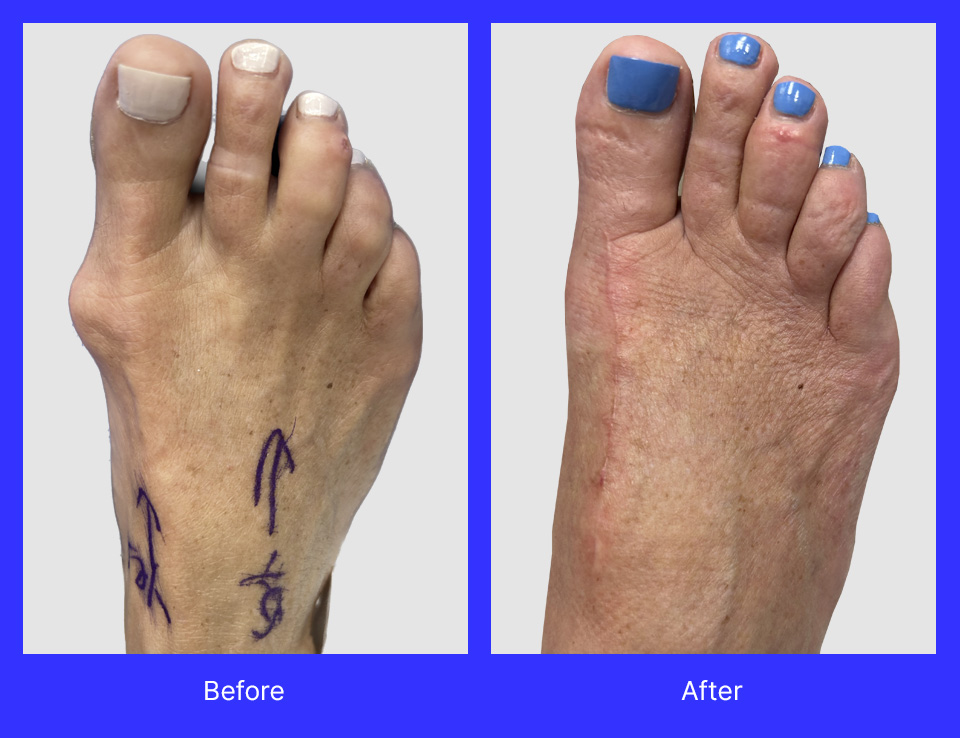
What is a bunion?
A bunion is a deviation of the big toe joint where the great toe, otherwise known as the first or big toe, moves towards the second toe. Where two bones that interface are called a joint. Typically, the 2 bones are straight and move on each other like a hinge on the door. When the two bones at the joint bend, you have a deviation in the joint.
If you look at your elbow and straighten it, you have the big toe joint. Now bend your elbow, and this is what happens in the big toe. As the big toe is meant to move up and down, it becomes painful when it moves to the side and then has to move up and down for you to walk. The bump that is noted can be significant over time, but it is a bone that has become more prominent than you feel.
What causes a bunion?
A bunion is hereditary and caused by genetics and what your ancestors have. It is the basic foot type that you inherit. The foot type and the position will lead to poor function when you rock, leading to deviation of the joints in the front and, thus, the bunion. The more active you are, the more stress and strain placed on the joint will cause the bunion to form faster. Pointy shoes can also make the bunion form faster over time, as the shape of the shoe causes the toe to turn in even more than it would naturally.
What are the treatment options for a bunion?
There are two main options—Conservative or nonsurgical care or surgery correction. Conservative care will not correct a bunion.
Conservative care includes:
- Change your shoes to wear a supportive pair of sneakers or supportive sandals.
- Use orthotic inserts. Orthotics, which are inserts that go into a shoe and control the mechanics of the foot and joint alignment, will help slow the progression of a bunion and help to decrease any pain in the big toe joint.
- If you develop an arthritic flare with inflammation, including a red hot and swollen big toe joint, you can use cortisone or steroid injections or oral anti-inflammatories. It is generally not recommended to inject cortisone into the deviated bunion. The reason for this is that steroid injections work very well in the short term to decrease pain and inflammation; however, the cortisone crystals stay in the joint and can break down the soft tissue, making the bunion condition worse over time.
- Protein-rich plasma (PRP) or amnion stem cells can also decrease inflammation but will not reverse the bunion.
- Over-the-counter splints will not correct the position either but may decrease any muscle spasm that one can have.
Surgery without the myths
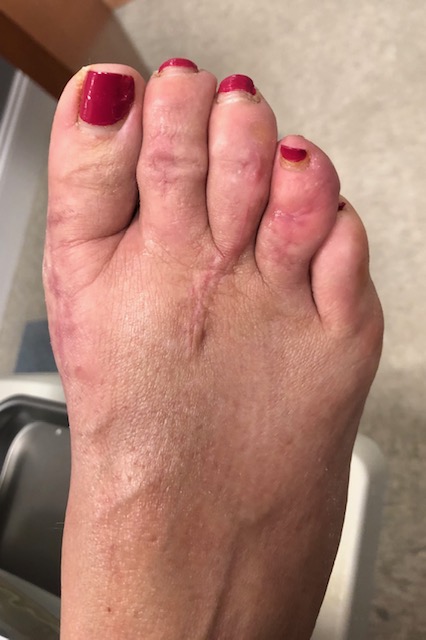
Bunion surgical correction includes realigning the first metatarsal bone and the big toe. The doctor will perform x-rays or scanning modalities to evaluate the structures and position of the foot and perform a procedure that is most appropriate to realign the position of the big toe joint. Most often, a bone cut is made in the first metatarsal, and a screw is used to fix the position.
Healing for this can take anywhere from 6 to 12 weeks, depending on how severe the condition is.
Some people who have bunions never have pain. In this group, no surgery is required to realign the joint if the bunion is not bothersome. Surgery can be performed if it starts to interfere with the activities you like to perform and the shoes you want to wear.
Orthotic Inner Soles
Orthotics are inserts that are placed into the soul of the shoe that controls your foot when you walk. There are various foot types, and no two people have the same foot type. When you walk, 26-foot bones have to remain aligned and work together efficiently to provide pain-free walking without developing problems as we age. Unfortunately, genetics, injuries, trauma, shoes, and activities can cause some problems in the foot.
The purpose of the orthotic is to take an altered position of the bone structures of the foot and realign them so that you can walk more easily. By walking more efficiently, your pain is significantly decreased or completely eradicated.
Orthotics fit into most sneakers, slip-on shoes, closed-back shoes, and some open sandals that have a removable footbed. There are various ways to measure the foot for an orthotic. At the Foot, Ankle & Leg Vein Center, we perform a walking gait analysis, a biomechanical foot examination, and re-position the foot for casting. We perform a cast mold or electronic scan of the foot so that a specific insert device is made for you.
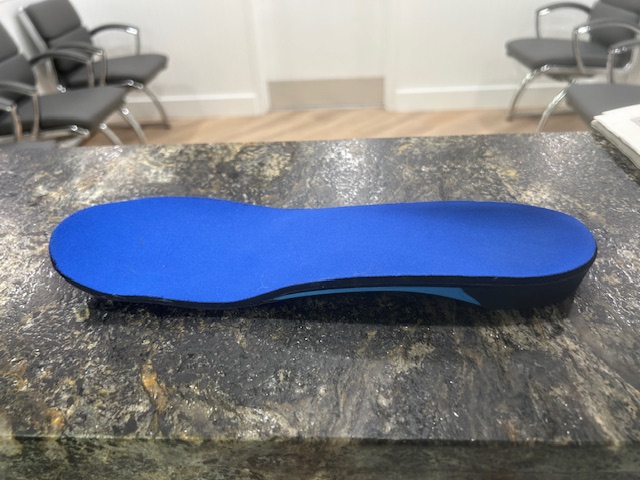
There are many ways people can develop and analyze the foot for an orthotic.
Some include a foam box, walking across the mat, or plaster casting. The plaster cast method is the original method designed a hundred years ago and has been shown and proven to still be the best way to analyze the foot and get it in the corrected position. This is performed by the doctors themselves.
Modifications can be built into a custom device to accommodate various conditions such as the metatarsal ball of the foot, neuromas, heel pain, or plantar fasciitis.
What is the difference between custom-molded orthotics and an over-the-counter device?
1. A custom-molded device is explicitly made for cure-for-type. No two feet are alike. An over-the-counter insert is typically designed for the general public with a one-size-fits-all concept.
1. A custom molded orthotics will last you many years, while an over-the-counter device is designed to last an average of three months.
2. Modifications can be made into a custom device for a foot problem, but not in an over-the-counter insert.
Here are some analogies to help you understand what an orthotic does and how it can help.
Orthotics are like eyeglasses. If you have poor vision, you go to an eye doctor, who makes a prescription lens that you can put on glasses to see better. You have an altered type of orthotic made for your foot so that you can walk more efficiently when you wear it.
Similar to eyeglasses that will not correct your vision, orthotics will not correct your foot, so when you don’t wear the device (glasses or the foot insert), they will not help you. Orthotics will not correct the foot, so when you wear them, they will not work.
Orthotics are like a retainer after braces. After corrective foot surgery, it is recommended that the alignment be maintained with an orthotic.
The difference between getting an over-the-counter orthotic versus a custom device is like getting magnifiers instead of a prescription lens.
Talk to a Talented Podiatrist Today
Forget the myths you’ve heard about bunion surgery. It’s not your grandmother’s bunion surgery! At the Foot, Ankle & Leg Vein Center, you will receive world-class care with effective treatment options.
In the long term, treating a bunion can eliminate pain and restore mobility. Enjoy the freedom to live life without foot and toe pain. Contact us now to schedule your consultation.
